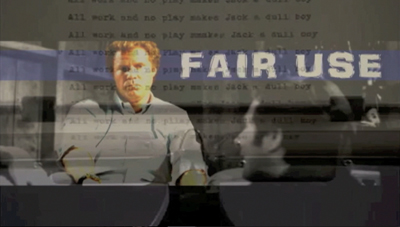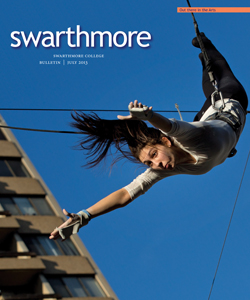Fan Fare

Julia Levin Russo ’01 evokes the fertile collisions between forms and cultures of vernacular video in the era of YouTube in mashup videos like this one from “Oh Internet (A Viding/Remix Romance).” She created this remix as part of the introduction to the 2012 Fan/Remix Video special issue of Transformative Works and Cultures, which she co-edited with Francesca Coppa.
This year, film and media studies, which was established in 1999 as a concentration, became Swarthmore’s newest department. With 18 majors and minors graduating in June, film and media studies has grown into a vital hub of curricular offerings and programming on campus—one that cultivates a community of engaged and collaborative students, faculty, and alumni. Swarthmore’s embrace of this new area of research reflects changes in academia as well as in the interests of its students.
Associate Professor Bob Rehak, who was granted tenure this spring, is one key to the department’s success. Rehak works at the intersection of several emerging fields, including fan studies. His recent faculty lecture “Materializing Monsters” featured his new research on the postwar market for movie-monster model kits. More than Meets the Eye, his forthcoming book, analyzes special effects in the Star Trek, Star Wars, The Lord of the Rings, and The Matrix franchises.
At a College legendary for its science-fiction student group, Swarthmore Warders of Imaginative Literature (SWIL, founded in 1978), it is not surprising that Rehak’s classes are popular. Will Hopkins ’11, now working in information technology at the University of Pennsylvania’s Positive Psychology Center and former co-president of Psi Phi, SWIL’s successor group, calls Rehak’s Fan Culture “the most influential class that I took at Swarthmore.”
“Fan activities weren’t legitimized, and things that fans produced did not have merit,” Hopkins adds. “Studying this material gave us a completely new perspective. More than just validating our interests, [Rehak] encouraged us to pursue them. That kind of relationship to a professor is Swarthmore.”
This spring, students taking Fan Culture with Rehak, Television and New Media with Sunka Simon, associate professor of German studies and film and media studies, and my own Feminist Film and Media Studies classes converged at a guest lecture on campus.
Muhlenberg College English Professor Francesca Coppa spoke about the practice of women’s vidding—fan-generated music videos that remix scenes from beloved television shows such as Buffy the Vampire Slayer and Supernatural. Coppa is a founder of the Organization of Transformative Works (OTW), which publishes the online academic journal Transformative Works and Cultures and advocates for remix culture. Her lecture followed a hugely successful event co-organized by Rehak last spring, when Henry Jenkins, University of Southern California professor and éminence grise of fan studies (see his 1992 study Textual Poachers among other works), spoke to an enthusiastic collegewide audience on transmedia storytelling.
For me, reflecting on the synergy of fan creativity, scholarly output, and formal film and media studies at Swarthmore is bittersweet. One of my most gifted students, Emily Salzfass ’99, passed away from heart failure this January. Emily’s contributions to the fan world were legendary. An archive of Our Own, the online fan fiction archive that is OTW’s flagship project, lists 154 works by Salzfass. As a freelance writer, she was known for a story in the Battlestar Galactica manga Echoes of New Caprica.
I heard the sad news about Emily’s passing from our mutual friend (and my former student) Julie Levin Russo ’01 at the annual conference of the Society for Cinema and Media Studies, where Russo was one of several Swatties presenting work.
Russo wrote her senior honors thesis for English literature on queer Star Trek: Voyager fan fiction. A Transformative Works and Cultures board member who publishes scholarly works and online fan fiction, Russo is a prominent “acafan”—an academic who identifies as a fan. Russo, who begins a permanent teaching position at Evergreen College this fall, got her Ph.D. from Brown University’s influential department of modern culture and media, where Brandy Monk-Payton ’07 is currently researching her dissertation on blackness, celebrity, and the dark side of publicity in media culture—after completing an M.A. thesis on Britney Spears at New York University.
The vitality of this area of research among Swarthmore faculty, alumni, and students is evidence that the school’s reputation for academic seriousness and serious fun is well deserved. I’m proud to be part of the community of film and media studies at Swarthmore—I’m also its biggest fan.
Patricia White is professor and founding chair of film and media studies. She is working on the fourth edition of The Film Experience with Timothy Corrigan, and her book Women’s Cinema/World Cinema: Projecting 21st Century Feminisms is forthcoming from Duke University Press in 2014.
 Email This Page
Email This Page